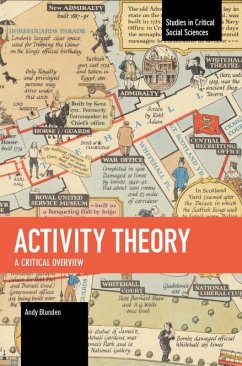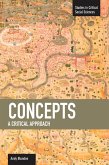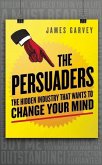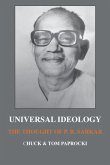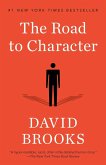27,99 €
inkl. MwSt.
Versandfertig in über 4 Wochen

14 °P sammeln
- Broschiertes Buch
- Merkliste
- Auf die Merkliste
- Bewerten Bewerten
- Teilen
- Produkt teilen
- Produkterinnerung
- Produkterinnerung
Andy Blunden completes his immanent critique of Activity Theory, begun in 2010 with An Interdisciplinary Theory of Activity. A summary of the ontological foundations of Activity Theory introduces a critical review of the work of activity theorists across the world with a focus of applications in medical and educational contexts, and concludes with a review of the ethics of collaboration. Blunden expands the domain of Activity Theory to address the pressing problems facing humanity today and activities lacking in clear objects, collaboration in voluntary projects and social movements, the life…mehr
Andere Kunden interessierten sich auch für
![Concepts Concepts]() Andy BlundenConcepts32,99 €
Andy BlundenConcepts32,99 €![The Persuaders The Persuaders]() James GarveyThe Persuaders13,99 €
James GarveyThe Persuaders13,99 €![Confronting Evil Confronting Evil]() Fred Emil KatzConfronting Evil36,99 €
Fred Emil KatzConfronting Evil36,99 €![Universal Ideology: The Thought of P.R. Sarkar Universal Ideology: The Thought of P.R. Sarkar]() Chuck PaprockiUniversal Ideology: The Thought of P.R. Sarkar20,99 €
Chuck PaprockiUniversal Ideology: The Thought of P.R. Sarkar20,99 €![Totem and Taboo: Some Points of Agreement Between the Mental Lives of Savages and Neurotics Totem and Taboo: Some Points of Agreement Between the Mental Lives of Savages and Neurotics]() Sigmund FreudTotem and Taboo: Some Points of Agreement Between the Mental Lives of Savages and Neurotics19,99 €
Sigmund FreudTotem and Taboo: Some Points of Agreement Between the Mental Lives of Savages and Neurotics19,99 €![Foucault on Leadership Foucault on Leadership]() Nathan HarterFoucault on Leadership53,99 €
Nathan HarterFoucault on Leadership53,99 €![The Road to Character The Road to Character]() David BrooksThe Road to Character24,99 €
David BrooksThe Road to Character24,99 €-
-
-
Andy Blunden completes his immanent critique of Activity Theory, begun in 2010 with An Interdisciplinary Theory of Activity. A summary of the ontological foundations of Activity Theory introduces a critical review of the work of activity theorists across the world with a focus of applications in medical and educational contexts, and concludes with a review of the ethics of collaboration. Blunden expands the domain of Activity Theory to address the pressing problems facing humanity today and activities lacking in clear objects, collaboration in voluntary projects and social movements, the life projects of individuals and emerging practices. Blunden brings an understanding of Marxist and Hegelian philosophy to bear on the application of Activity Theory to problems of social change.
Hinweis: Dieser Artikel kann nur an eine deutsche Lieferadresse ausgeliefert werden.
Hinweis: Dieser Artikel kann nur an eine deutsche Lieferadresse ausgeliefert werden.
Produktdetails
- Produktdetails
- Verlag: Haymarket Books
- Seitenzahl: 236
- Erscheinungstermin: 11. Juni 2024
- Englisch
- Abmessung: 229mm x 152mm x 13mm
- Gewicht: 340g
- ISBN-13: 9798888902400
- Artikelnr.: 69920447
- Herstellerkennzeichnung
- Libri GmbH
- Europaallee 1
- 36244 Bad Hersfeld
- gpsr@libri.de
- Verlag: Haymarket Books
- Seitenzahl: 236
- Erscheinungstermin: 11. Juni 2024
- Englisch
- Abmessung: 229mm x 152mm x 13mm
- Gewicht: 340g
- ISBN-13: 9798888902400
- Artikelnr.: 69920447
- Herstellerkennzeichnung
- Libri GmbH
- Europaallee 1
- 36244 Bad Hersfeld
- gpsr@libri.de
Andy Blunden is an independent scholar in Melbourne, Australia, who has written on Activity Theory, collaboration and collective decision making, social movements and Hegelian philosophy. Andy is Secretary of the Marxists Internet Archive, and former editor of Mind, Culture & Activity.
Preface
Acknowledgements
List of Figures and Tables
Part 1
Basic Principles of Activity Theory
1 Introduction
1 Behaviour, Consciousness and Activity
2 Substance, Monism and Dualism
3 Continuity and Discontinuity
4 Actions, Goals and Motives
4.1 Operations
5 Artefacts
5.1 Words, Tools and Signs
6 Activities
6.1 What Is an Activity
6.2 Activities Which Fall Short of Leontyev’s Ideal-Typical Activity
7 Motivation
7.1 The “Unconscious”?
8 The Genealogy of Activity Theory
9 Activity Theory and Vygotsky’s Socio-cultural Theory
10 Germ Cell and Unit of Analysis
11 Activities and Concepts
12 Abstract and Concrete
13 Analysis by Units and Analysis by Elements
13.1 Monism Again
14 Subject, Object and Participant Research
15 Activities Have a Life Cycle
16 The Context of Activities
16.1 The Immediate and Societal Contexts of Activities
16.2 The Historical Context of Activities
17 Perezhivanie
18 The Development of the Personality
19 Narrative Analysis
20 Summary: Motivation
Part 2
Diverse Research in Activity Theory
Introduction to Part 2
2 Building Institutions
1 A Child Learning to Read.
1.1 Question Asking Reading (King, Griffin, et al.)
1.2 Putting Academic Knowledge to Work
2 Vasilyuk’s Work on Resolving “Impossible Situations”
2.1 Types of “Life-World”
2.2 Types of Perezhivanie
3 A Wage Worker Employed in a Capitalist Firm
3 Activities Characterised by a Narrative
1 The Life Course of an Individual Person
1.1 Luria’s Romantic Science
2 The Narrative of a Patient Visiting a Hospital and Receiving Treatment
2.1 The Story of a Female Trainee Surgeon Who Chooses to Leave Training
2.2 A Medical Student in Their First Months as a Hospital Doctor
3 The History of a Practice, Such as a Science or Profession
4 Transformative Projects
1 The Activist Stance
1.1 Agency
1.1.1 Vygotsky on Self-Control
1.1.2 Sannino on Collective Decision Making
1.1.3 Gutierrez on Transgression
1.1.4 Stetsenko on Agency
1.1.5 Holland and Edwards on Relational Agency
1.1.6 Horton on Freedom
1.1.7 Discussion
2 The Germ Cell of a New Practice
2.1 Marx’s Use of the Idea of a Germ Cell or Unit in Capital
2.1.1 The Introduction of Trade into a Traditional Society
2.2 Vygotsky Made Word Meaning a Unit of Analysis
2.2.1 Concepts and Activities
2.3 Vasily Davydov’s Mathematics Curriculum
5 Intervening with Activity Theory
1 Transforming Activities with a Germ Cell
1.1 The Sit-to-Stand Exercise
1.2 Junior Doctors Using Purple Pen for Prescribing
1.3 Collaborative Learning Spaces
1.4 The “Root Model” for Teaching Topics in School
6 Political Life
1 A Trade Union Organising Workers in an Enterprise
2 Rival Political Parties Competing for Government of the Country
2.1 Elections
2.2 The Formation of Public Opinion
7 Social Movements
1 The Women’s Liberation Movement
1.1 The Life Cycle of the wlm
1.2 The wlm as a Learning Process
1.3 Decision Making within Projects
1.4 Transforming the Object-Concept
1.5 Relations between Projects
1.6 The Urpraxis of a Movement
8 Incoherent Activities
1 Activities Characterised by a Shared Motif
1.1 The Solar Punk Youth Movement
1.2 The Anti-vax Campaign against Public Health Measures
9 Formative Interventions
1 Construction of Utopian Forms of Activity as Educational Artefacts
1.1 Mike Cole et al.’s 5th Dimension
1.2 Aydin Bal’s Learning Lab
1.3 Fernanda Liberali’s lace
2 Postcolonial Projects
10 Ethics
1 The Ethics of Collaboration
1.1 Social Science and Ethics
1.2 Modern Ethics
1.2.1 Religion and Ethics
1.2.2 John Rawls’ Political Liberalism
1.2.3 Habermas’s Communicative Ethics
1.2.4 Seyla Benhabib
1.2.5 Amartya Sen
1.2.6 Agnes Heller
1.2.7 Alasdair MacIntyre
1.2.8 Thick and Thin Ethos
1.3 Collaborative Ethics
1.4 Participant Researchers
2 Social Class
3 The Urpraxis of Socialism
3.1 The Worldwide Anti-capitalist Struggle
Conclusion
References
Index
Acknowledgements
List of Figures and Tables
Part 1
Basic Principles of Activity Theory
1 Introduction
1 Behaviour, Consciousness and Activity
2 Substance, Monism and Dualism
3 Continuity and Discontinuity
4 Actions, Goals and Motives
4.1 Operations
5 Artefacts
5.1 Words, Tools and Signs
6 Activities
6.1 What Is an Activity
6.2 Activities Which Fall Short of Leontyev’s Ideal-Typical Activity
7 Motivation
7.1 The “Unconscious”?
8 The Genealogy of Activity Theory
9 Activity Theory and Vygotsky’s Socio-cultural Theory
10 Germ Cell and Unit of Analysis
11 Activities and Concepts
12 Abstract and Concrete
13 Analysis by Units and Analysis by Elements
13.1 Monism Again
14 Subject, Object and Participant Research
15 Activities Have a Life Cycle
16 The Context of Activities
16.1 The Immediate and Societal Contexts of Activities
16.2 The Historical Context of Activities
17 Perezhivanie
18 The Development of the Personality
19 Narrative Analysis
20 Summary: Motivation
Part 2
Diverse Research in Activity Theory
Introduction to Part 2
2 Building Institutions
1 A Child Learning to Read.
1.1 Question Asking Reading (King, Griffin, et al.)
1.2 Putting Academic Knowledge to Work
2 Vasilyuk’s Work on Resolving “Impossible Situations”
2.1 Types of “Life-World”
2.2 Types of Perezhivanie
3 A Wage Worker Employed in a Capitalist Firm
3 Activities Characterised by a Narrative
1 The Life Course of an Individual Person
1.1 Luria’s Romantic Science
2 The Narrative of a Patient Visiting a Hospital and Receiving Treatment
2.1 The Story of a Female Trainee Surgeon Who Chooses to Leave Training
2.2 A Medical Student in Their First Months as a Hospital Doctor
3 The History of a Practice, Such as a Science or Profession
4 Transformative Projects
1 The Activist Stance
1.1 Agency
1.1.1 Vygotsky on Self-Control
1.1.2 Sannino on Collective Decision Making
1.1.3 Gutierrez on Transgression
1.1.4 Stetsenko on Agency
1.1.5 Holland and Edwards on Relational Agency
1.1.6 Horton on Freedom
1.1.7 Discussion
2 The Germ Cell of a New Practice
2.1 Marx’s Use of the Idea of a Germ Cell or Unit in Capital
2.1.1 The Introduction of Trade into a Traditional Society
2.2 Vygotsky Made Word Meaning a Unit of Analysis
2.2.1 Concepts and Activities
2.3 Vasily Davydov’s Mathematics Curriculum
5 Intervening with Activity Theory
1 Transforming Activities with a Germ Cell
1.1 The Sit-to-Stand Exercise
1.2 Junior Doctors Using Purple Pen for Prescribing
1.3 Collaborative Learning Spaces
1.4 The “Root Model” for Teaching Topics in School
6 Political Life
1 A Trade Union Organising Workers in an Enterprise
2 Rival Political Parties Competing for Government of the Country
2.1 Elections
2.2 The Formation of Public Opinion
7 Social Movements
1 The Women’s Liberation Movement
1.1 The Life Cycle of the wlm
1.2 The wlm as a Learning Process
1.3 Decision Making within Projects
1.4 Transforming the Object-Concept
1.5 Relations between Projects
1.6 The Urpraxis of a Movement
8 Incoherent Activities
1 Activities Characterised by a Shared Motif
1.1 The Solar Punk Youth Movement
1.2 The Anti-vax Campaign against Public Health Measures
9 Formative Interventions
1 Construction of Utopian Forms of Activity as Educational Artefacts
1.1 Mike Cole et al.’s 5th Dimension
1.2 Aydin Bal’s Learning Lab
1.3 Fernanda Liberali’s lace
2 Postcolonial Projects
10 Ethics
1 The Ethics of Collaboration
1.1 Social Science and Ethics
1.2 Modern Ethics
1.2.1 Religion and Ethics
1.2.2 John Rawls’ Political Liberalism
1.2.3 Habermas’s Communicative Ethics
1.2.4 Seyla Benhabib
1.2.5 Amartya Sen
1.2.6 Agnes Heller
1.2.7 Alasdair MacIntyre
1.2.8 Thick and Thin Ethos
1.3 Collaborative Ethics
1.4 Participant Researchers
2 Social Class
3 The Urpraxis of Socialism
3.1 The Worldwide Anti-capitalist Struggle
Conclusion
References
Index
Preface
Acknowledgements
List of Figures and Tables
Part 1
Basic Principles of Activity Theory
1 Introduction
1 Behaviour, Consciousness and Activity
2 Substance, Monism and Dualism
3 Continuity and Discontinuity
4 Actions, Goals and Motives
4.1 Operations
5 Artefacts
5.1 Words, Tools and Signs
6 Activities
6.1 What Is an Activity
6.2 Activities Which Fall Short of Leontyev’s Ideal-Typical Activity
7 Motivation
7.1 The “Unconscious”?
8 The Genealogy of Activity Theory
9 Activity Theory and Vygotsky’s Socio-cultural Theory
10 Germ Cell and Unit of Analysis
11 Activities and Concepts
12 Abstract and Concrete
13 Analysis by Units and Analysis by Elements
13.1 Monism Again
14 Subject, Object and Participant Research
15 Activities Have a Life Cycle
16 The Context of Activities
16.1 The Immediate and Societal Contexts of Activities
16.2 The Historical Context of Activities
17 Perezhivanie
18 The Development of the Personality
19 Narrative Analysis
20 Summary: Motivation
Part 2
Diverse Research in Activity Theory
Introduction to Part 2
2 Building Institutions
1 A Child Learning to Read.
1.1 Question Asking Reading (King, Griffin, et al.)
1.2 Putting Academic Knowledge to Work
2 Vasilyuk’s Work on Resolving “Impossible Situations”
2.1 Types of “Life-World”
2.2 Types of Perezhivanie
3 A Wage Worker Employed in a Capitalist Firm
3 Activities Characterised by a Narrative
1 The Life Course of an Individual Person
1.1 Luria’s Romantic Science
2 The Narrative of a Patient Visiting a Hospital and Receiving Treatment
2.1 The Story of a Female Trainee Surgeon Who Chooses to Leave Training
2.2 A Medical Student in Their First Months as a Hospital Doctor
3 The History of a Practice, Such as a Science or Profession
4 Transformative Projects
1 The Activist Stance
1.1 Agency
1.1.1 Vygotsky on Self-Control
1.1.2 Sannino on Collective Decision Making
1.1.3 Gutierrez on Transgression
1.1.4 Stetsenko on Agency
1.1.5 Holland and Edwards on Relational Agency
1.1.6 Horton on Freedom
1.1.7 Discussion
2 The Germ Cell of a New Practice
2.1 Marx’s Use of the Idea of a Germ Cell or Unit in Capital
2.1.1 The Introduction of Trade into a Traditional Society
2.2 Vygotsky Made Word Meaning a Unit of Analysis
2.2.1 Concepts and Activities
2.3 Vasily Davydov’s Mathematics Curriculum
5 Intervening with Activity Theory
1 Transforming Activities with a Germ Cell
1.1 The Sit-to-Stand Exercise
1.2 Junior Doctors Using Purple Pen for Prescribing
1.3 Collaborative Learning Spaces
1.4 The “Root Model” for Teaching Topics in School
6 Political Life
1 A Trade Union Organising Workers in an Enterprise
2 Rival Political Parties Competing for Government of the Country
2.1 Elections
2.2 The Formation of Public Opinion
7 Social Movements
1 The Women’s Liberation Movement
1.1 The Life Cycle of the wlm
1.2 The wlm as a Learning Process
1.3 Decision Making within Projects
1.4 Transforming the Object-Concept
1.5 Relations between Projects
1.6 The Urpraxis of a Movement
8 Incoherent Activities
1 Activities Characterised by a Shared Motif
1.1 The Solar Punk Youth Movement
1.2 The Anti-vax Campaign against Public Health Measures
9 Formative Interventions
1 Construction of Utopian Forms of Activity as Educational Artefacts
1.1 Mike Cole et al.’s 5th Dimension
1.2 Aydin Bal’s Learning Lab
1.3 Fernanda Liberali’s lace
2 Postcolonial Projects
10 Ethics
1 The Ethics of Collaboration
1.1 Social Science and Ethics
1.2 Modern Ethics
1.2.1 Religion and Ethics
1.2.2 John Rawls’ Political Liberalism
1.2.3 Habermas’s Communicative Ethics
1.2.4 Seyla Benhabib
1.2.5 Amartya Sen
1.2.6 Agnes Heller
1.2.7 Alasdair MacIntyre
1.2.8 Thick and Thin Ethos
1.3 Collaborative Ethics
1.4 Participant Researchers
2 Social Class
3 The Urpraxis of Socialism
3.1 The Worldwide Anti-capitalist Struggle
Conclusion
References
Index
Acknowledgements
List of Figures and Tables
Part 1
Basic Principles of Activity Theory
1 Introduction
1 Behaviour, Consciousness and Activity
2 Substance, Monism and Dualism
3 Continuity and Discontinuity
4 Actions, Goals and Motives
4.1 Operations
5 Artefacts
5.1 Words, Tools and Signs
6 Activities
6.1 What Is an Activity
6.2 Activities Which Fall Short of Leontyev’s Ideal-Typical Activity
7 Motivation
7.1 The “Unconscious”?
8 The Genealogy of Activity Theory
9 Activity Theory and Vygotsky’s Socio-cultural Theory
10 Germ Cell and Unit of Analysis
11 Activities and Concepts
12 Abstract and Concrete
13 Analysis by Units and Analysis by Elements
13.1 Monism Again
14 Subject, Object and Participant Research
15 Activities Have a Life Cycle
16 The Context of Activities
16.1 The Immediate and Societal Contexts of Activities
16.2 The Historical Context of Activities
17 Perezhivanie
18 The Development of the Personality
19 Narrative Analysis
20 Summary: Motivation
Part 2
Diverse Research in Activity Theory
Introduction to Part 2
2 Building Institutions
1 A Child Learning to Read.
1.1 Question Asking Reading (King, Griffin, et al.)
1.2 Putting Academic Knowledge to Work
2 Vasilyuk’s Work on Resolving “Impossible Situations”
2.1 Types of “Life-World”
2.2 Types of Perezhivanie
3 A Wage Worker Employed in a Capitalist Firm
3 Activities Characterised by a Narrative
1 The Life Course of an Individual Person
1.1 Luria’s Romantic Science
2 The Narrative of a Patient Visiting a Hospital and Receiving Treatment
2.1 The Story of a Female Trainee Surgeon Who Chooses to Leave Training
2.2 A Medical Student in Their First Months as a Hospital Doctor
3 The History of a Practice, Such as a Science or Profession
4 Transformative Projects
1 The Activist Stance
1.1 Agency
1.1.1 Vygotsky on Self-Control
1.1.2 Sannino on Collective Decision Making
1.1.3 Gutierrez on Transgression
1.1.4 Stetsenko on Agency
1.1.5 Holland and Edwards on Relational Agency
1.1.6 Horton on Freedom
1.1.7 Discussion
2 The Germ Cell of a New Practice
2.1 Marx’s Use of the Idea of a Germ Cell or Unit in Capital
2.1.1 The Introduction of Trade into a Traditional Society
2.2 Vygotsky Made Word Meaning a Unit of Analysis
2.2.1 Concepts and Activities
2.3 Vasily Davydov’s Mathematics Curriculum
5 Intervening with Activity Theory
1 Transforming Activities with a Germ Cell
1.1 The Sit-to-Stand Exercise
1.2 Junior Doctors Using Purple Pen for Prescribing
1.3 Collaborative Learning Spaces
1.4 The “Root Model” for Teaching Topics in School
6 Political Life
1 A Trade Union Organising Workers in an Enterprise
2 Rival Political Parties Competing for Government of the Country
2.1 Elections
2.2 The Formation of Public Opinion
7 Social Movements
1 The Women’s Liberation Movement
1.1 The Life Cycle of the wlm
1.2 The wlm as a Learning Process
1.3 Decision Making within Projects
1.4 Transforming the Object-Concept
1.5 Relations between Projects
1.6 The Urpraxis of a Movement
8 Incoherent Activities
1 Activities Characterised by a Shared Motif
1.1 The Solar Punk Youth Movement
1.2 The Anti-vax Campaign against Public Health Measures
9 Formative Interventions
1 Construction of Utopian Forms of Activity as Educational Artefacts
1.1 Mike Cole et al.’s 5th Dimension
1.2 Aydin Bal’s Learning Lab
1.3 Fernanda Liberali’s lace
2 Postcolonial Projects
10 Ethics
1 The Ethics of Collaboration
1.1 Social Science and Ethics
1.2 Modern Ethics
1.2.1 Religion and Ethics
1.2.2 John Rawls’ Political Liberalism
1.2.3 Habermas’s Communicative Ethics
1.2.4 Seyla Benhabib
1.2.5 Amartya Sen
1.2.6 Agnes Heller
1.2.7 Alasdair MacIntyre
1.2.8 Thick and Thin Ethos
1.3 Collaborative Ethics
1.4 Participant Researchers
2 Social Class
3 The Urpraxis of Socialism
3.1 The Worldwide Anti-capitalist Struggle
Conclusion
References
Index
